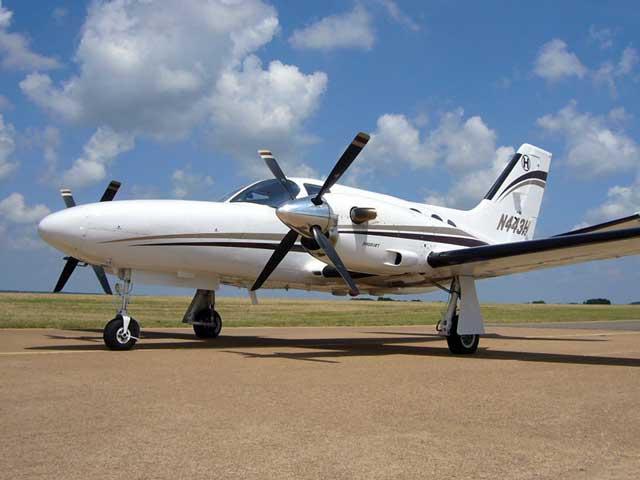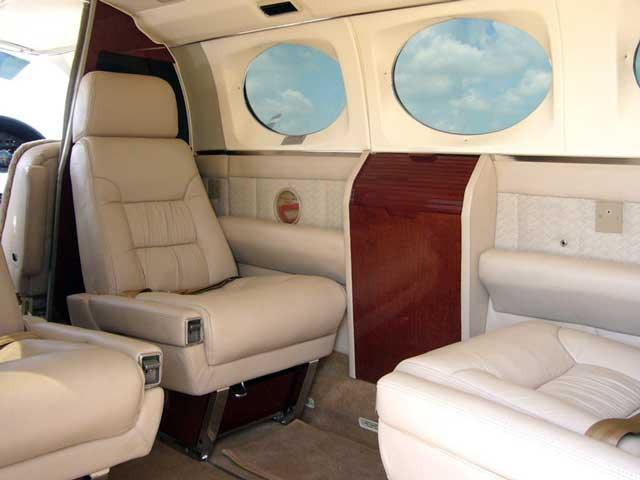


Aircraft Description
Background/History
In November 1977, Cessna announced that it was developing the Model 425. It was to be a turboprop-powered, cabin class twin based upon the already-successful 421 piston-engined twin. The 425, later named the Corsair, was powered by a pair of Pratt & Whitney PT6A-112 turboprops. The maiden flight of the prototype was accomplished in September 1978 and FAA certification was obtained in mid-1980. The horizontal stabilizer employed a significant dihedral, and the landing gear was strengthened over that of the 421 in order to allow an increase in landing weight and ramp weight. In 1983, Cessna renamed the 425 the Conquest I, while the original Conquest (the Model 441) was redesignated Conquest II. First deliveries were in November 1980, and the 425 line was discontinued in 1986 after a production run of 236 units.
Power
The Cessna 425 Conquest I is powered by a pair of Pratt & Whitney PT6A-112 turboprop engines rated at 450 shp each, driving three-blade, full-feathering, constant speed propellers. Inspection interval on the engines is 3,600 hours.
Avionics
Most Conquest I’s were originally delivered with 1000-series Cessna avionics, including dual comms, dual navs, dual transponders, dual ADF, dual DME, and autopilot. Also common in the Conquest I are Collins avionics, including dual VHF 20A comms, dual VIR 30A navs, ADF 60, DME 40, FIS 70 flight director/HSI system, Sperry 1000 autopilot, and WXR 300 CLR weather radar.
Design Features
The Cessna Conquest I is a light, pressurized, twin-turboprop business aircraft configured as a cantilever low-wing monoplane with a conventional tail. The horizontal stabilizer employs a large dihedral angle in order to minimize its exposure to prop wash. The airframe is of aluminum monocoque construction. Ground handling is aided by the proportionally wide track of the retractable tricycle landing gear which utilizes a single wheel on each unit. The undercarriage has also been strengthened in comparison with that of the Cessna 421 (from which the 425 is derived) in order to allow for higher landing and ramp weights.
Accomodations
The Cessna Conquest I is found in a variety of seating configurations, typically configured for six or seven passengers. A lavatory seat is available for the aft cabin, along with a baggage space of 51 cu. ft. An additional 26 cu. ft. of baggage space is available in the nose locker. Internal cabin dimensions are 4.3ft. in height, 4.6ft. in width and 10.6ft. in length.
| General | Conquest I, CE-425 | |||
|---|---|---|---|---|
| Category | Multiengine Turboprop < 12,500 lbs. | |||
| Years Aircraft Manufactured | 1981 – 1986 | |||
| Serial Number Range | 425-0001 – 425-0236 | |||
| Retail High Price | $1,495,000.00 / 1,173,126.50€ | |||
| Retail Low Price | $450,000.00 / 353,115.00€ | |||
| Characteristics | Conquest I, CE-425 | |||
| Seating | 1 + 6/7 | |||
| Wing Loading | 38.2 | |||
| Power Loading | 9.6 | |||
| Noise(EPNdB): Takeoff/Sideline/Approach | 72.3 | |||
| External Dimensions (ft) | Conquest I, CE-425 | |||
| External Length | 35.9 | |||
| External Height | 12.6 | |||
| External Span | 44.1 | |||
| Internal Dimensions (ft) | Conquest I, CE-425 | |||
| Internal Length (Overall/Net Height) | 10.6 | |||
| Internal Height | 4.3 | |||
| Internal Width (Max/Floor) | 4.6 | |||
| Baggage | Conquest I, CE-425 | |||
| External: Cu.Ft./Lb. | N/A | |||
| External: Cu.Ft./Lb. | N/A | |||
| Power | Conquest I, CE-425 | |||
| Engines | 2 P&WC PT6A-112 | |||
| Output (lbs ea.)/Flat Rating | 450shp | |||
| Inspection Interval | 3,600t | |||
| Data based on latest manufactured year | ||||



